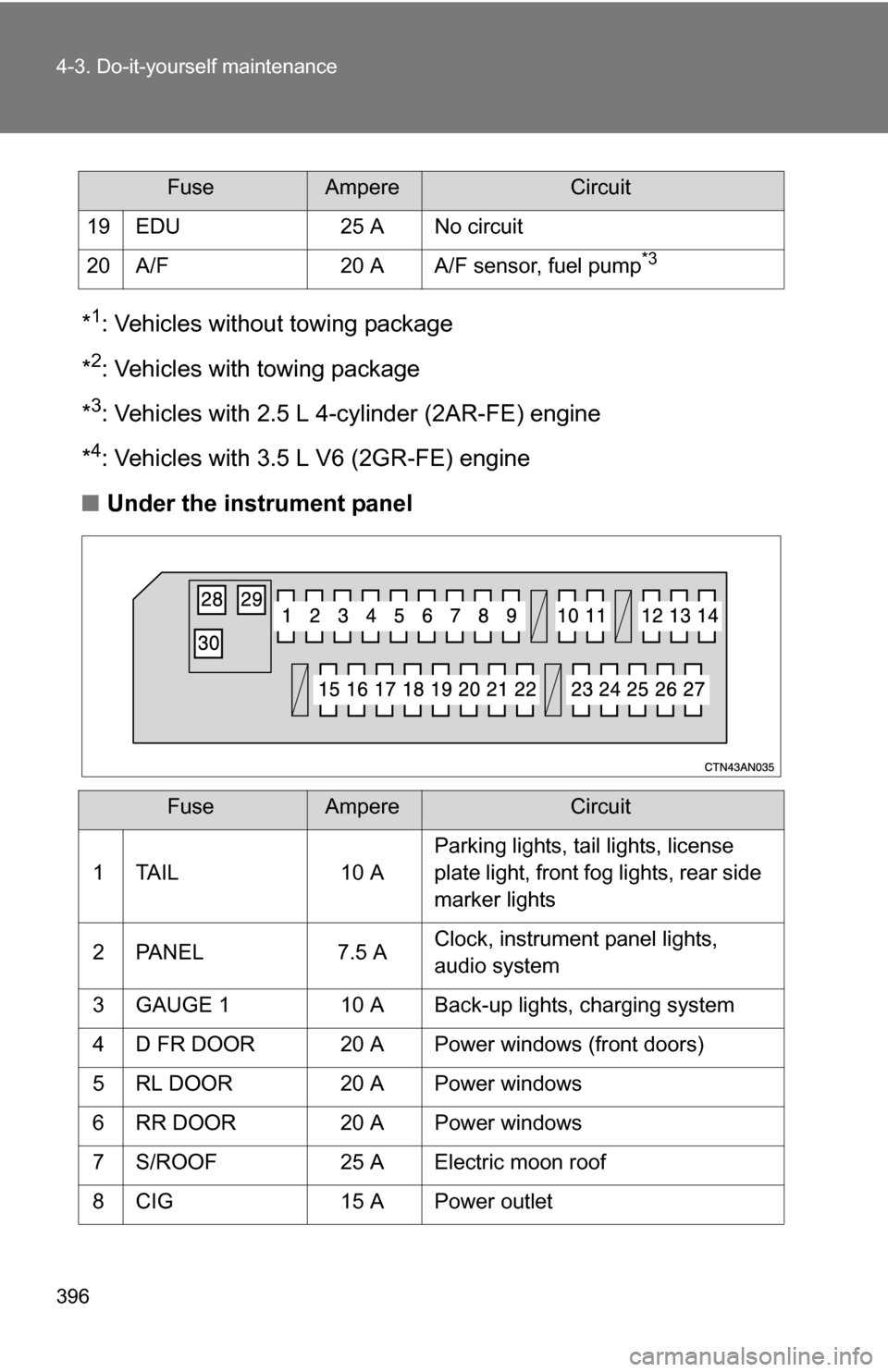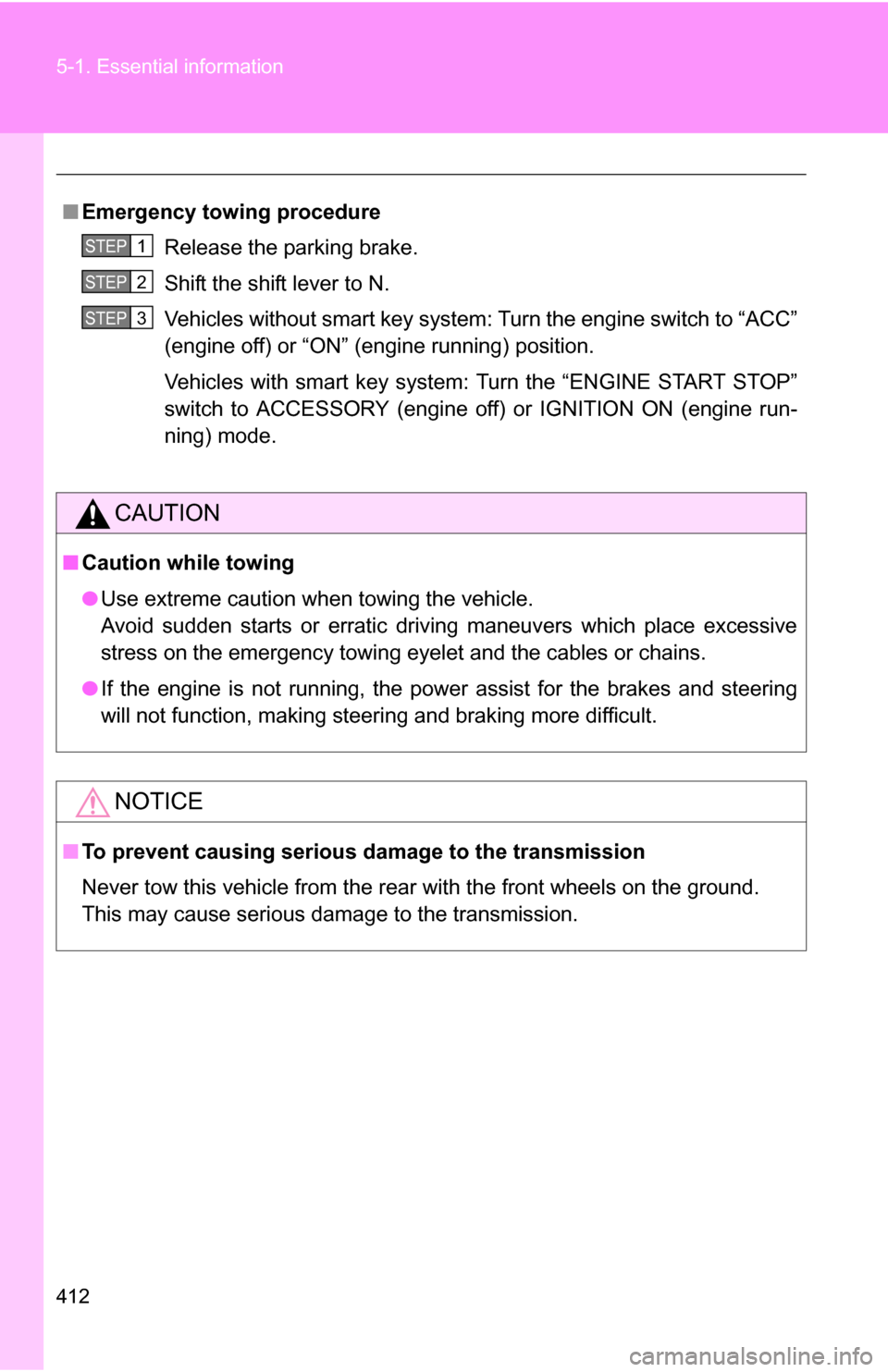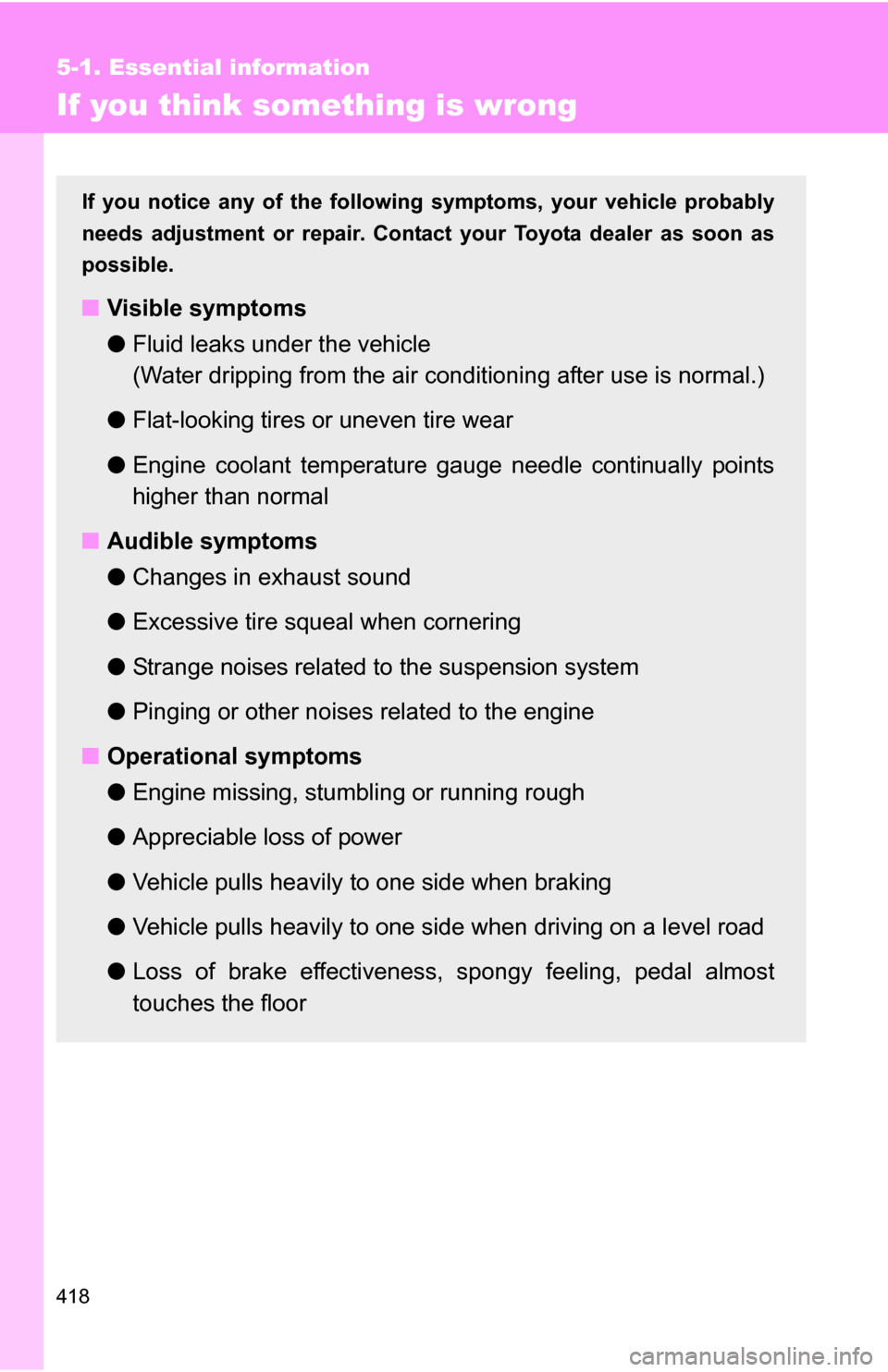engine TOYOTA RAV4 2009 XA30 / 3.G Owners Manual
[x] Cancel search | Manufacturer: TOYOTA, Model Year: 2009, Model line: RAV4, Model: TOYOTA RAV4 2009 XA30 / 3.GPages: 516, PDF Size: 10.61 MB
Page 393 of 516

393
4-3. Do-it-yourself maintenance
4
Maintenance and care
8 ECU-B
10 AGauges and meters, clock, main
body ECU, wireless remote control,
smart key system, audio system,
front passenger occupant classifi-
cation system, ABS, TRAC,
Enhanced VSC system, “AUTO
LSD”, downhill assist control sys-
tem, hill-start assist control system,
Active torque control 4WD system
9 DOME 10 AVanity lights, personal/interior
lights, interior light, luggage com-
partment light, engine switch light,
foot lights
10 H-LP LH 10 A Left-hand headlight (high beam)
11 H-LP RH 10 A Right-hand headlight (high beam)
12 H-LP LL 10 A Left-hand headlight (low beam)
13 H-LP RL 10 A Right-hand headlight (low beam)
14 AC INV 15 A AC inverter
15 TOWING*
130 A No circuit
16 DEICER 20 A Windshield wiper deicer
17 HTR 50 A Air conditioning system
18 PTC NO.3 50 A No circuit
19 PTC NO.2 50 A No circuit
20 PTC NO.1 50 A No circuit
21 HEAD MAIN 50 A “H-LP LH”, “H-LP RH”, “H-LP LL”,
“H-LP RL” fuses
22 RDI*
230 A
Electric cooling fan
FA N 2 *
150 A
FuseAmpereCircuit
Page 394 of 516

394 4-3. Do-it-yourself maintenance
*1: Vehicles with towing package
*
2: Vehicles with 2.5 L 4-cylinder (2AR-FE) engine
*
3: Vehicles with 3.5 L V6 (2GR-FE) engine
Type B (driver’s side)
23 CDS*
230 A
Electric cooling fan
FA N 1 *
350 A
24 H-LP CLN 30 A No circuit
FuseAmpereCircuit
1 AMP 30 A Audio system
2 AM2 30 A Starting system
3 IG2 15 A Starting system, multiport fuel
injection system/sequential multi-
port fuel injection system
4 HAZ 10 A Emergency flashers
5 ETCS 10 A Multiport fuel injection system/
sequential multiport fuel injection
system
FuseAmpereCircuit
Page 396 of 516

396 4-3. Do-it-yourself maintenance
*1: Vehicles without towing package
*
2: Vehicles with towing package
*
3: Vehicles with 2.5 L 4-cylinder (2AR-FE) engine
*
4: Vehicles with 3.5 L V6 (2GR-FE) engine
■ Under the instrument panel
19 EDU 25 A No circuit
20 A/F 20 A A/F sensor, fuel pump
*3
FuseAmpereCircuit
1 TAIL 10 A Parking lights, tail lights, license
plate light, front fog lights, rear side
marker lights
2 PANEL 7.5 A Clock, instrument panel lights,
audio system
3 GAUGE 1 10 A Back-up lights, charging system
4 D FR DOOR 20 A Power windows (front doors)
5 RL DOOR 20 A Power windows
6 RR DOOR 20 A Power windows
7 S/ROOF 25 A Electric moon roof
8 CIG 15 A Power outlet
FuseAmpereCircuit
Page 400 of 516

400
4-3. Do-it-yourself maintenance
Light bulbs
You may replace the following bulbs yourself. The difficulty level of
replacement varies depending on the bulb. If necessary bulb
replacement seems difficult to perfor m, contact your Toyota dealer.
For more information about replacing other light bulbs, contact your
Toyota dealer.
■ Preparing a light bulb for replacement
Check the wattage of the light bulb being replaced. ( P. 476)
■ Removing the engine compartment cover
P. 354
■ Front bulb locations
Headlight
low beam
Front turn signal, parking and
front side marker lights
Headlight high beam
Front fog lights
(if equipped)
Page 409 of 516

When trouble arises5
409
5-1. Essential informationEmergency flashers ......... 410
If your vehicle needs to be towed ............................. 411
If you think something is wrong ......................... 418
Fuel pump shut off system ........................... 419
Event data recorder ......... 420 5-2. Steps to take in an
emergency
If a warning light turns on or a warning buzzer
sounds... ....................... 422
If you have a flat tire (vehicles with standard
tires) ............................... 434
If you have a flat tire (vehicles with run-flat
tires) ............................... 450
If the engine will not start ................................ 451
If the shift lever cannot be shifted from P............ 453
If you lose your keys ........ 454
If the electronic key does not operate properly
(vehicles with smart
key system).................... 455
If the battery is discharged ..................... 457
If your vehicle overheats ....................... 460
If the vehicle becomes stuck .............................. 463
Page 410 of 516

410
5-1. Essential information
Emergency flashers
NOTICE
■To prevent battery discharge
Do not leave the emergency flashers on longer than necessary when the
engine is not running.
Use the emergency flashers if th e vehicle malfunctions or is
involved in an accident.
Press the switch to flash all
the turn signal lights. To turn
them off, press the switch
once again.
Page 411 of 516

5
When trouble arises
411
5-1. Essential information
If your vehicle needs to be towed
Before towingThe following may indicate a problem with your transmission. Contact
your Toyota dealer before towing.
● The engine is running, but the vehicle will not move.
● The vehicle makes an abnormal sound.
Emergency towing
If a tow truck is not available, in an emergency your vehicle may be
temporarily towed using a cable or chain secured to the emergency
towing eyelet. This should only be attempted on hard surfaced roads
for short distances at low speeds.
A driver must be in the vehicle to steer and operate the brakes. The
vehicle’s wheels, drive train, axles, steering and brakes must be in
good condition.
Towing eyelet
If towing is necessary, we recommend having your vehicle towed by
your Toyota dealer or a commerci al towing service, using a lift-type
truck or a flat bed truck.
Use a safety chain system for all to wing, and abide by all state/pro-
vincial and local laws.
2WD models: If towing from the fr ont, the vehicle's rear wheels and
axles must be in good conditions. (P. 415)
If they are damaged, use a towing dolly or flat bed truck.
Page 412 of 516

412 5-1. Essential information
■Emergency towin g procedure
Release the parking brake.
Shift the shift lever to N.
Vehicles without smart key system: Turn the engine switch to “ACC”
(engine off) or “ON” (engine running) position.
Vehicles with smart key system: Turn the “ENGINE START STOP”
switch to ACCESSORY (engine off) or IGNITION ON (engine run-
ning) mode.
CAUTION
■ Caution while towing
●Use extreme caution when towing the vehicle.
Avoid sudden starts or erratic driving maneuvers which place excessive
stress on the emergency towing eyelet and the cables or chains.
● If the engine is not running, the power assist for the brakes and steering
will not function, making steering and braking more difficult.
NOTICE
■To prevent causing serious dama ge to the transmission
Never tow this vehicle from the rear with the front wheels on the ground.
This may cause serious damage to the transmission.
STEP 1
STEP 2
STEP 3
Page 418 of 516

418
5-1. Essential information
If you think something is wrong
If you notice any of the following symptoms, your vehicle probably
needs adjustment or repair. Contact your Toyota dealer as soon as
possible.
■ Visible symptoms
●Fluid leaks under the vehicle
(Water dripping from the air cond itioning after use is normal.)
● Flat-looking tires or uneven tire wear
● Engine coolant temperature g auge needle continually points
higher than normal
■ Audible symptoms
●Changes in exhaust sound
● Excessive tire squeal when cornering
● Strange noises related to the suspension system
● Pinging or other noises related to the engine
■ Operational symptoms
●Engine missing, stumbling or running rough
● Appreciable loss of power
● Vehicle pulls heavily to one side when braking
● Vehicle pulls heavily to one side when driving on a level road
● Loss of brake effectiveness, s pongy feeling, pedal almost
touches the floor
Page 419 of 516

5
When trouble arises
419
5-1. Essential information
Fuel pump shut off system
Follow the procedure below to restart the engine after the system is
activated.
Vehicles without smart key system Turn the engine switch to the “ACC” or “LOCK” position.
Restart the engine.
Vehicles with smart key system Turn the “ENGINE START STOP” switch OFF.
Restart the engine.
NOTICE
■Before starting the engine
Inspect the ground under the vehicle.
If you find that fuel has leaked onto the ground, the fuel system has been
damaged and is in need of repair. Do not restart the engine.
To minimize the risk of fuel leakage when the engine stalls or an air-
bag inflates upon collision, the fu el pump shut off system stops sup-
plying fuel to the engine.
STEP 1
STEP 2
STEP 1
STEP 2